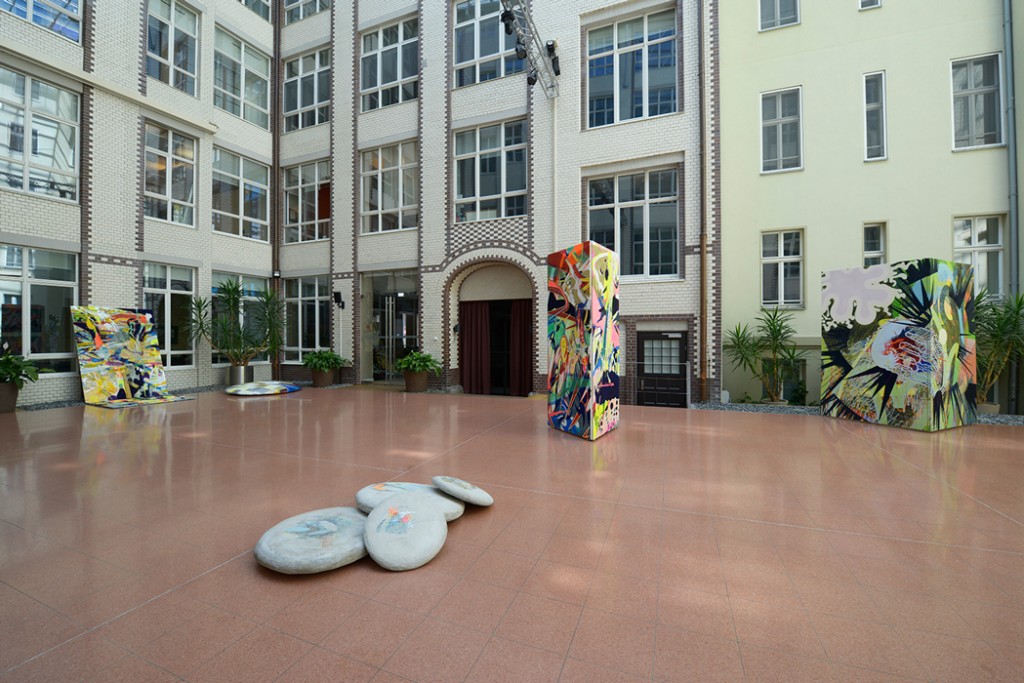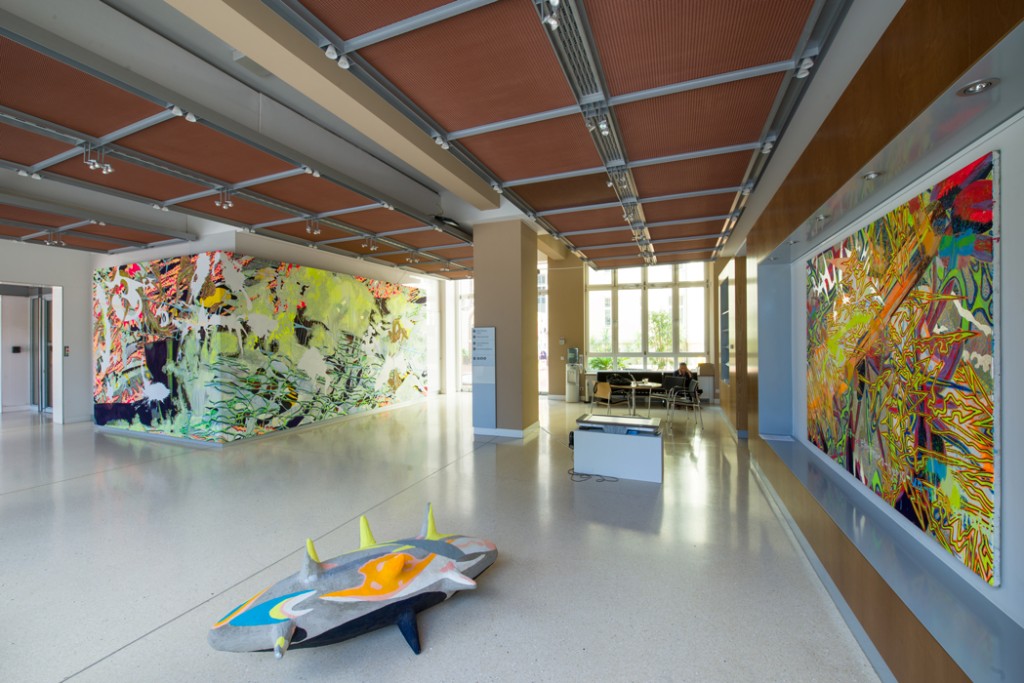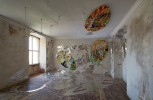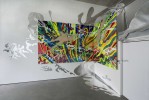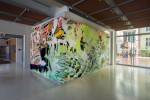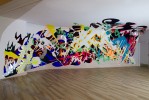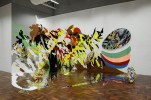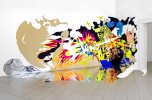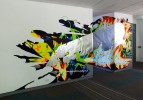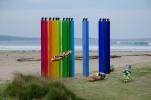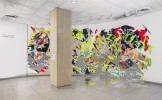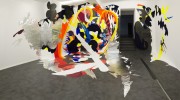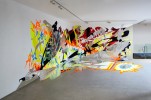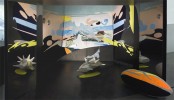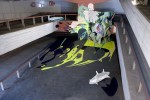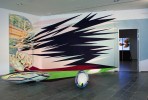mutopia 5
MUTOPIA 5
CLAUDIA CHASELING | SPATIAL PAINTING
Curated by Rachel Rits-Volloch
Design by Emilio Rapanà
At the Australian Embassy Berlin in collaboration with Momentum
30 June – 30 October 2020
Mass Destruction from Mass Distraction
Mass Distraction from Mass Destruction
Splashes of bright colors in biomorphic forms. Shapes and hues redolent of crackling, explosive energy. Large format works overflowing the gallery walls. Visitors to an exhibition of Claudia Chaseling’s work are confronted with a psychotropic saturation of visual information interlaced with occasional text and the URLs of source materials for Chaseling’s research. For, what seems initially to be pure abstraction, is in fact so much more. Chaseling began her “mutopia” series in 2011, honing her technique of Spatial Painting to focus on visualizing the nuclear chain that leads to radioactive contamination and its mutative effect on living things. Chaseling’s inquiry into the ways that abstract, non-representational painting can communicate narratives with a socio-political meaning - namely, the radioactive contamination of depleted uranium munitions – became the subject of her practice-based PhD, awarded by the Australian National University in Canberra in 2019. That she is now able to show the body of work resulting from her research at the Australian Embassy in her home city of Berlin, is a tribute to the 21 years Chaseling has been living between Australia and Germany, as well as to the Embassy’s commitment to culture, even in these precarious times. This exhibition was realized during the COVID-19 pandemic outbreak and resulting lockdown, at a time when most other cultural institutions were canceling or postponing their programs. The two new site-specific works made especially for this exhibition were able to be completed in time only because the artist obtained her materials the day before shops closed for the lockdown. And while the eyes and hearts of the world were focused on the viral threat and aftermath of COVID-19, Claudia Chaseling, working in her studio throughout the lockdown, was addressing another kind of insidious invisible killer: radiation and its repercussions.
As the title of this exhibition suggests, this is the 5th iteration of the “mutopia” body of work. And true to its subject matter, with each iteration, the exhibition mutates into something new, adapting to the architecture of its space with the creation of new site-specific works. “Mutopia” – Claudia Chaseling’s verbal paradox, comingling the terms mutation and utopia – has been her core subject matter since 2011, with the creation of “Murphy the Mutant”, Chaseling’s graphic novel of watercolors animated on video. This narrative work effectively describes her fixation upon the enduring environmental devastation of nuclear waste and munitions, transposing into a paradoxically sweet atomic allegory, akin to a children’s book, the horrific aftermath of the way we wage war in the modern world. This early work, shown in this exhibition alongside Chaseling’s newest 9-meter long site-specific Spatial Painting, “mutopia 5”, created for the Australian Embassy Berlin, illustrates the trajectory of her practice over the past decade. The visual language Chaseling has created and the imagery in her work consists of distorted landscapes, poisoned places, mutated creatures and plants whose deformation is caused by radioactive contamination. Her images are not predictions of some post-apocalyptic future, but rather the result of her research into historic and ongoing ways in which we continue to poison our planet with the byproducts of wars and nuclear accidents. To ground the psychedelic fantasy of her imagery in the harsh realities of the nuclear chain her work exposes, Chaseling embeds within her paintings quotations and URLs referencing her source materials, mapping the places polluted by depleted uranium, an environmental contaminant that is a derivative waste product of nuclear power and nuclear weapons technology. To further highlight the sociopolitical content of her work, Chaseling has for the first time teamed up with designer Emilio Rapanà to make a site-specific collaborative work for this exhibition. “Now”, a triptych comingling design, text citing sources on depleted uranium, and a selection of Chaseling’s watercolors, is a mixed-media framework foregrounding the artist’s research, revealing the content underlying her whole body of work in a new form.
The tension in Claudia Chaseling’s practice of Spatial Painting lies precisely in the gap between its form and its content. Visually striking, beautifully colorful, the work is seductive, attracting the eye to its complexity of layers; in the artist’s own words “dissolving landscapes into compositions of toxic colour that comprise negative shapes and abstract forms”. But lurking within the abstract form is the concrete content - difficult truths about our energy and arms industries, literal ticking time-bombs too often glossed over by the media and buried by political pressure. Because the topics Chaseling addresses are ugly, she strives to keep her work from becoming too aesthetic, using negative space, leaving gaps within her imagery to leave room for interpretation. Just as her work can be read on the levels of both form and content, Chaseling builds a duality of perspective into the foundations of her practice. Striving for the moment “when a painting becomes an environment”, the artist “proposes a novel understanding of spatiality, one that reaches beyond formalism, reaching into today’s political landscape…to awaken our attention to environmental damages caused by man-made radioactive radiation, which is mutating nature”. Chaseling’s terminology “Spatial Painting” refers to this technique of producing sociopolitically inflected works which are at once 2 and 3-dimensional, created in such a way that when seen from a particular point of view, the works come to appear paradoxically flat. This is no easy feat in a practice where the works tend to morph into the architecture of their exhibition space, overflowing the bounds of their canvases, exploding onto the ceilings, melting onto the floors, oozing onto the walls to bend around corners. In the past, much of Chaseling’s expanded painting has been created within the exhibition space itself, and accordingly designed to be temporary, existing only for the duration of each show. However, taking a new direction in her practice, her most recent Spatial Painting “mutopia 5” was made during the 3 months of pandemic lockdown entirely in the artist’s studio, but with the site-specific point of perspective designed for the architecture of the exhibition space at the Australian Embassy.
“mutopia 5” is an exhibition of Spatial Painting featuring 16 works, ranging in media from painting to watercolor, sculpture, print, and video. Encompassing a decade of Claudia Chaseling’s artistic practice, this body of work takes us on a psychedelic journey through the nuclear chain leading to depleted uranium and its toxic aftermath. In developing her technique of Spatial Painting, Chaseling’s intent is in “transforming perception, distorting it to disseminate political content.” Chaseling’s preoccupation with depleted uranium and the mutations it causes is somehow rendered even more relevant now, in the time of Corona, when suddenly we are all seeming experts on the mutations of viral strains, on the mistakes made at a cellular level, the glitches in genetic code causing mutations. It took a global pandemic to stop the world in its tracks beneath the threat of an invisible killer which pays no heed to national borders or political will. Yet Claudia Chaseling has been painting another such invisible killer for over a decade. Why is it that no amount of media coverage and political protest - no amount of outrage at dirty bombs and weapons testing - can stop the invisible killer of radiation poisoning our planet? Why could not the global tragedies of Hiroshima and Nagasaki, Chernobyl or Fukushima also stop the world in its tracks? This exhibition is a warning, a wake-up-call exploding onto our retinas in poison pigments, and invading our consciousness with information we should find as terrifying as any pandemic. As the artist maintains, “mass destruction is enabled by mass distraction”. Using her visual language of Spatial Painting to both inform and protest about the fatal status quo of global energy and arms industries, Claudia Chaseling has for over a decade persevered in focusing our attention on the pernicious weapon of mass destruction which is depleted uranium. Yet in designating this body of work “mutopia”, she does so with hope for a better future. For, perhaps this conflation of mutation and utopia is not the oxymoron it first appears to be. Mutations in the DNA of living things caused by radioactive isotopes is the stuff of sci-fi horror. Yet, from the very beginning of life on this planet, genetic mutation has also been a survival mechanism. Without such mutations over the course of millennia, we would not exist. If we enable our planet to survive long enough, perhaps we too may change into something better.
Together with the Australian Embassy Berlin, MOMENTUM is proud to present Claudia Chaseling’s solo exhibition “mutopia 5” as part of its 10th Anniversary Program, celebrating the foundation of MOMENTUM in Sydney, Australia in 2010.
[Rachel Rits-Volloch, Founding Director of MOMENTUM]
